Integrating Oracle WebCenter and Oracle BI EE Part 1 : Introducing Oracle WebCenter Portal 11g
Many years ago I wrote an article for OTN on integrating Oracle Discoverer content into Oracle Portal, where Discoverer (for those of you new to Oracle BI) was the predecessor to OBIEE and Oracle Portal was Oracle's enterprise portal product. Since then we've of course moved on to OBIEE, and last year I put together a presentation with fellow Oracle ACE Director Andrejus Baranovskis around integrating OBIEE 11g with Oracle's Application Development Framework, a toolkit used in conjunction with JDeveloper to create browser-based applications. But what about customers who want to combine OBIEE content with an out-of-the-box portal, as we used to do with Discoverer and Oracle Portal? What are the options now?
The spiritual successor to Oracle Portal is in fact a product called Oracle WebCenter, a much wider-ranging product line that covers areas such as social media and collaboration, web-based portals, toolkits for portals and content management. WebCenter, like Oracle BI, is a product suite in itself and is part of the Fusion Middleware family, and provides the "user experience" part of products like the Oracle Fusion Applications, which combine traditional line-of-business applications with wikis, forums and Facebook-style status updates. WebCenter as a whole is made up of a number of products (a bit like Oracle BI Foundation), with the overall product set made up of WebCenter Sites (based on software that came with the Fatwire acquisition), WebCenter Portal and WebCenter Social (developed in-house by Oracle), and WebCenter Content (based on technology from Stellent).
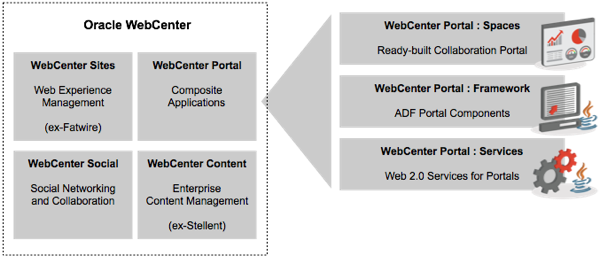
WebCenter Portal itself is then made up of a number of products; WebCenter Portal : Framework, a set of Oracle ADF components for adding portal-type functionality to ADF applications; WebCenter Portal : Services, Web 2.0-style services for wikis, forums, collaboration and so forth, and WebCenter Portal : Spaces, a ready-built Portal application that uses Framework and Services components to create something that looks familiar to users of Oracle's old Oracle Portal product.
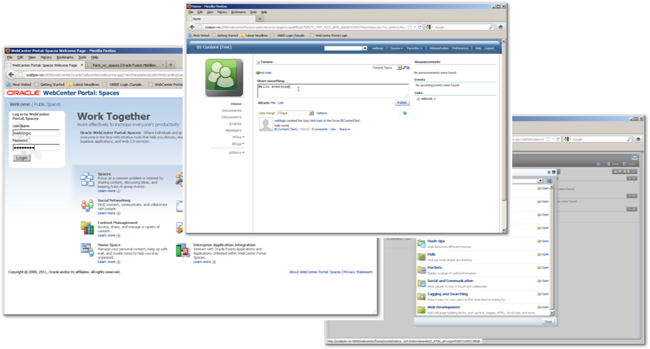
So where this gets interesting for us BI developers, is that we can use WebCenter as an overall UI framework for BI content, in the same way that Oracle have used it to deliver the Fusion Applications, to create composite web-based applications that contain transactional content, BI visuals and collaboration tools such as forums, commentary, wikis, status updates and the like. Now this was the promise of the OBIEE / ADF integration examples we put together last year, but ADF in its "raw" state is very low-level (compared to working with a portal), whereas WebCenter gives us most of the components we need "ready-built", through the WebCenter Portal : Services features that you can add to a portal page using a tool called "Oracle Composer".
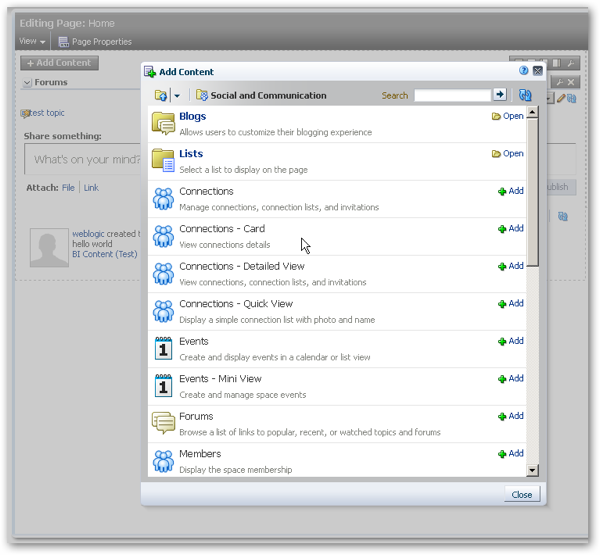
So what's involved in using Oracle WebCenter Portal, and how do you go about putting together a simple, composite portal application. What does the technology stack look like, and how much do you need to know JDeveloper, and Java development? Over the next couple of days we'll look into the WebCenter Portal development process in conjunction with OBIEE content, but for now let's take a quick look at the technology stack, and how you can get yourself up and running with a WebCenter / OBIEE development environment.
Oracle Fusion Middleware is a suite of products from Oracle that provides the mid-tier infrastructure for your applications and business processes. Made up of home-grown products and products acquired through acquisitions such as BEA, Fusion Middleware comprises of a set of core servers supported by development and management tools based around Oracle WebLogic Server (and, to a limited extent, IBM WebSphere Application Server) and Java Enterprise Edition.
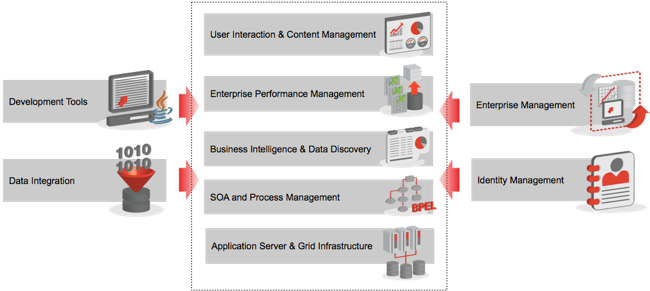
Applications created using Fusion Middleware are generally built using JDeveloper 11g and the Application Development Framework (ADF); WebCenter is built using ADF and provides pre-built UI functionality together with content management, collaboration and other Web 2.0-style services. Oracle Business Intelligence, as we all know, provides features such as the Enterprise Semantic Model, a report catalog, a rich set of calculation functionality and the ability to create interactive reports and dashboards sourcing data from relational, multidimensional and other data sources.
To install WebCenter Portal, you typically need to put together the following technology stack:
- A 64-bit Operating system (32-bit is possible but not ideal) usually running Linux, or maybe Windows
- Oracle WebLogic Server Enterprise Edition
- Oracle WeCenter Content (the UCM element) for the content management
- Oracle Fusion Middleware Web Tier (not mandatory, but recommended for the UCM part)
- Oracle WebCenter Portal
A full set of installation prerequisites and links to the downloads are on the Oracle WebCenter Portal 11g Installation page, on OTN. Once you've set everything up, you end up with a WebLogic domain and a number of WebLogic managed servers, each of which runs part of the WebCenter / WebCenter Portal stack, like this:
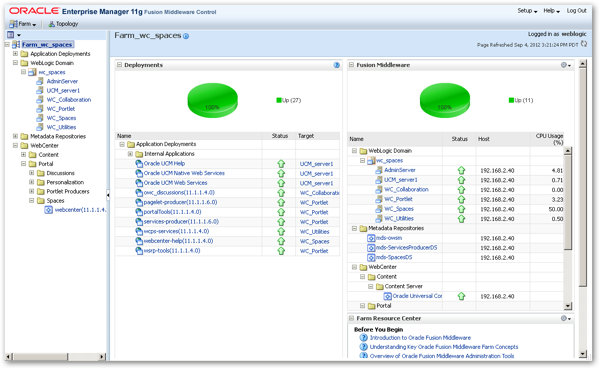
If you end up putting all of the managed servers on the same machine, you'll need a fairly meaty server - I've got my WebCenter setup running on a VM on a 16GB RAM Mac Mini server, and the VM is currently allocated 10GB of RAM. In a real-world situation you'd probably spread the managed servers over more than one box, but for testing purposes you can get it all running on a 16GB laptop or workstation.
Thankfully, you can also download a developer VM from OTN that has the SOA, BPM and WebCenter software pre-installed, which is what I've used as the base for my integration work. If you're going to use this VM for WebCenter Portal development though, there's a few additional tasks that you'll need to perform on the VM before you can really use it; mainly, you'll need to extend the base WebCenter domain to include additional managed servers for portal utilities and portlets, and then register the out-of-the-box portlets that these new servers provide so that you can do things like add parameter forms, use the omniportlet, and so on. But in the end, it works, and it saves you going through the whole install process.
So, anyway, that's enough of the introduction. In the next two posts I'll be looking at integrating OBIEE 11g content into WebCenter Portal : Spaces and wiring it together using parameters and events, and in the final posting, I'll be looking at what's involved in using ADF and the WebCenter Portal : Framework toolkit to created custom portals that include OBIEE Presentation Catalog content.